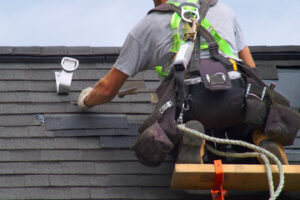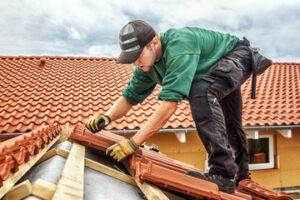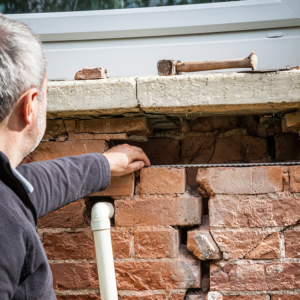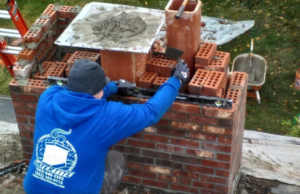When left unchecked, roofing issues can escalate to significant damage. Regular roof maintenance can prevent these problems from occurring and allow you to keep your warranty intact.

In addition to inspecting the shingles, look at the caulking around chimneys and vent pipes. Also, check for moss and lichen that can degrade surface materials over time.
One of the first steps in shingle maintenance is to inspect the shingles. A ground-level inspection is best, but if you need to use a ladder make sure it’s secure and take the time to carefully walk around each shingle. If you are able to safely do so, look for damage such as bare spots or gaps. You can also check for curling or buckling shingles, which is indicative of wear and tear. Cracked or broken shingles are susceptible to water leaks and must be replaced. The shingles should be properly aligned to prevent moisture from infiltrating the home.
A shingle roof’s flashing is the material that seals the area where the roof plane meets a vertical surface such as a chimney or dormer. The flashing is critical for preventing water leaks. Look for areas where the flashing has separated from the roofing materials or is missing altogether. You should also check for rust on the nails and any signs of moisture in the attic space.
It’s important to do a thorough inspection of your roof twice a year, once in the spring and once in the fall. You should also inspect it after any severe weather events. Missing or damaged shingles can cause a variety of problems including water leaks, mold growth and structural damage. Regular inspections can catch these issues before they become worse.
During your roof’s inspection, pay attention to the gutters. They should be free of debris, dirt and branches that can clog the gutters and push moisture (and ice if it’s winter) beneath your shingles. It’s also a good idea to inspect the caulking and vent pipes for any looseness or cracking. Look for moss, lichen and plant growth as these are indicators of deteriorating materials.
If you are unable or prefer not to do a ground-level inspection, you can use a ladder to examine the shingles from the attic space. Be careful not to damage the attic space by overstepping your boundaries. Using binoculars is another option for getting a closer look at problem areas of the shingles. Water stains on the ceiling and walls are a clear indicator that there is a leak in your roof. Ignoring this issue can lead to expensive structural damage.
Inspect the Flashing
When flashing is properly installed it prevents leaks by creating a watertight seal around openings like chimneys, roof vents and skylights. The flashing also keeps moisture and air from under the roofing materials where rot and mold can develop. It’s essential that it be kept in good condition to ensure the longevity of the roofing material and keep the roof structurally sound.
In addition to the general maintenance of the shingles, it’s important that you inspect the flashing and other elements of the roof to catch problems before they get out of hand. These problems might include a leaky roof, a chimney that’s not functioning correctly or a vent that’s not providing sufficient ventilation for the house. Ideally, the roof should be inspected once per year and any small issues should be repaired immediately. This will help avoid more significant and costly issues in the future.
Most of the time, when a homeowner spots a leak or other problem with their roof, it’s because there is a problem with the flashing. These are often a bit difficult to spot as they’re often located around the corners of the roof where the walls meet, or near projections such as chimneys, dormers and vent pipes.
A lot of the time these flashing problems occur because the installation wasn’t done correctly during initial construction or reroofing. This is why it’s important to work with a reputable roofer who is knowledgeable about the correct methods of installing flashing and other components of the roof.
You can perform a basic eyeball inspection by walking around the building and gazing up at the areas where the roof meets the walls or any valleys and corners that contain flashing. Look for gaps or waviness in the flashing and pay special attention to areas where the seams are, as these are particularly susceptible to leaks.
If you find any cracks or holes in the flashing, repair them immediately with a good quality caulking. If you have metal flashing, check the metal for corrosion or other damage and replace it if necessary. Check for loose or missing sections of the flashing as well as rust or corroded spots in other places on the roof.
Trim Tree Branches
Keeping your trees healthy helps protect the roof of your home and provides a cooling effect on the property. Trimming your trees will help to prevent the growth of branches that can damage your roof or hang over it. Additionally, it will encourage the growth of healthier branches that can help to support the shingles. When you are trimming a tree, start by identifying the branches that need to be cut. Look for dead or weak branches, those that are growing too low and those that may touch the ground or power lines. Also, remove branches that have been damaged by pests or storms.
The first step in pruning a branch is to make an undercut on the underside of the branch about 20cm (8in) out from where you will be cutting it. Then make a second cut on the topside of the branch about 2.5cm (1in) further out. This will create a callus on the outside of the branch, which will compartmentalize it over time and prevent tearing. Finally, cut off the remaining stub at a 45-to-60-degree angle kicking out from the branch collar. Always make a clean, final cut and never seal pruning cuts with paint, as this can actually hinder the healing process.
Trimming branches can be done at any time of the year, but it’s best to prune after the tree has finished its spring growth. This will ensure that new growth is stronger and more mature, which will make it less susceptible to damage during storms or by animals.
When pruning a tree, you can use hand pruners for small branches and loppers for thicker limbs. When working with a large tree, a pole saw is usually necessary to reach the higher branches. Before making any cuts, always take the time to examine a branch from several angles and at different heights to ensure that you are not removing too much. Also, always work with a professional when pruning near or over power lines. Attempting to prune these types of branches without the proper training can lead to a serious accident.
Clean the Gutters
Clogged gutters are one of the leading causes of roof leaks. To keep them in good condition, you need to clean them regularly. Aiming the hose down each gutter can help clear blockages and help determine whether water is flowing freely. If not, you might need to replace them.
To avoid damaging the gutters, it is best not to lean on them with the hose or pressure washer. Instead, start at the end of a gutter and work your way down, making sure to rinse down the downspouts as well.
As you work along a section of the gutter, use a hand trowel to dig out any accumulated leaves or other organic matter. You can also sweep away moss or lichen with a broom. Ideally, you should also remove any twigs or other debris that might be sticking up through the gutter system.
Once you have cleared the gutters, make sure they are secure and not leaking or sagging. A sagging gutter will cause water to run off the side of your house and can damage the siding. Also, check the slope of the gutter to ensure it is correct; too steep a slope can cause clogs and even cause water to spill over the edge of the gutter.
If you are not comfortable climbing on a ladder to clean the gutters, there are companies that specialize in this type of home maintenance. They can be hired to clean the gutters from the ground without the need for a ladder, and they can also inspect the shingles and flashing on your roof for any damages or areas that might need repair. They can also trim tree branches that extend over the roof, which will prevent them from falling onto your shingles during storms and other harsh weather conditions. Unnecessary tree trimming can harm a healthy tree if done wrong, so it is important to hire a professional. This is something that can be done once a year or every other year, depending on how many trees are near your roof and how much foliage grows around them.








